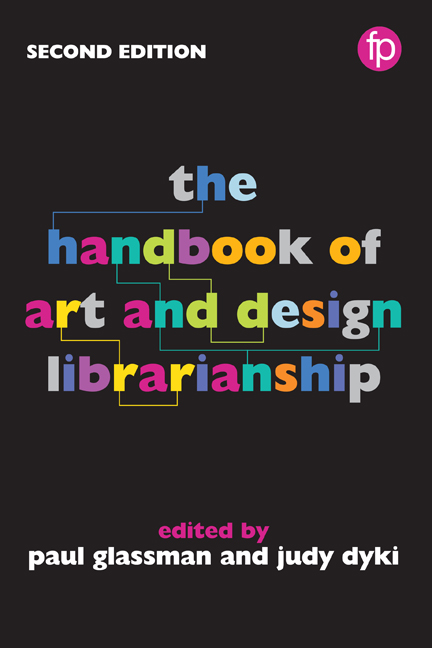Book contents
- Frontmatter
- Contents
- List of figures and tables
- Notes on contributors
- Foreword
- Preface
- Part I Roles and responsibilities
- 1 The governance and administration of the art and design library
- 2 Evolution not revolution: evolving trends in art and design libraries
- 3 Expanding roles for fine arts liaison librarians: re-visioning the liaison model
- 4 Accreditation and visual arts libraries
- 5 Design thinking for design librarians: rethinking art and design librarianship
- Part II Materials and collection management
- Part III Teaching and learning
- Part IV Knowledge creation
- Part V The physical environment
- Part VI Promotion and sustainability
- Appendix Library profiles
- Index
3 - Expanding roles for fine arts liaison librarians: re-visioning the liaison model
from Part I - Roles and responsibilities
Published online by Cambridge University Press: 08 June 2018
- Frontmatter
- Contents
- List of figures and tables
- Notes on contributors
- Foreword
- Preface
- Part I Roles and responsibilities
- 1 The governance and administration of the art and design library
- 2 Evolution not revolution: evolving trends in art and design libraries
- 3 Expanding roles for fine arts liaison librarians: re-visioning the liaison model
- 4 Accreditation and visual arts libraries
- 5 Design thinking for design librarians: rethinking art and design librarianship
- Part II Materials and collection management
- Part III Teaching and learning
- Part IV Knowledge creation
- Part V The physical environment
- Part VI Promotion and sustainability
- Appendix Library profiles
- Index
Summary
Academic libraries continue to wrestle with changes in higher education and their implications for library services. Over the past years, many libraries have re-evaluated the role of liaison librarians in their institutions and, in doing so, expanded their responsibilities to include greater outreach across campus with a resulting move from collection-centric models to models focused on engagement. The University of Minnesota is often cited as an early leader in this transition. Indeed, their position description framework is frequently used as a model for other research libraries. This description framework articulates several roles including campus engagement, scholarly communication, digital tools, outreach and exhibit and event planning (Jaguszewski and Williams, 2013). Since then, other areas of positional interest have and continue to emerge. In Duke University's revisioning of the liaison model, ‘Liaison librarians (subject librarians) are in the forefront of interacting with faculty, students, and researchers; their roles have been changing and will probably remain in a state of continuous change’ (Daniel et al., 2011).
Kenney (2014) identifies three emerging themes in the recent development of liaison models: engagement strategies with scholars, continued refinement of liaison roles to meet new demands, and a growing emphasis on promoting digital tools. With the expectations on liaison librarians continuing to rise, the pressure on them to ‘do it all’ can leave some with a feeling of uncertainty about how to prioritize and manage time, how to measure progress, or how to define success. As liaison models change, our tools for assessment needs to change as well. Kenney writes, ‘Shifting focus from what liaison librarians do to how their efforts impact faculty, students, and others will be critical to future development of this model’ (2014). At the same time, liaison librarians need not excel at every new skill that is added to their list of responsibilities. Instead, a more plausible aim is that of ‘continued refinement’, grounded in a liaison librarian's ability to establish useful partnerships with a colleague in the library or elsewhere on campus for leveraging relevant expertise (Jaguszewski and Williams, 2013).
- Type
- Chapter
- Information
- The Handbook of Art and Design Librarianship , pp. 25 - 32Publisher: FacetPrint publication year: 2017
- 1
- Cited by



